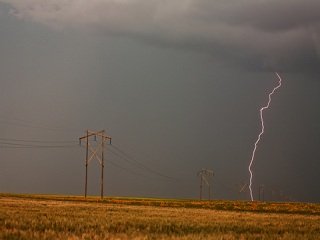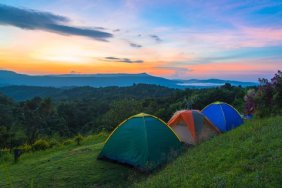 Weather in the backcountry can change without warning and without mercy. Travelers can and will endure flash floods, freezing temperatures, blistering heat, snow, and rain. And with rain, you can sometimes expect thunderstorms and lightning. Lightning is no laughing matter, and smart outdoorsmen know to take it seriously in the backcountry. Here are a few tips to keep you safe when lightning strikes during your trips to the trail.
Weather in the backcountry can change without warning and without mercy. Travelers can and will endure flash floods, freezing temperatures, blistering heat, snow, and rain. And with rain, you can sometimes expect thunderstorms and lightning. Lightning is no laughing matter, and smart outdoorsmen know to take it seriously in the backcountry. Here are a few tips to keep you safe when lightning strikes during your trips to the trail.
When lightning strikes up, it’s important to take immediate action to reduce your risk of injury. First, don’t go near any water. Secondly, you’ll need to move away from any tall, solitary objects, such as a tree or light post. Isolated high-rise objects are likely strike points for lightning, so distance yourself from them when the storm hits. You’ll also need to descend from ridgelines or peaks. Lightning tends to strike prominent topographic features, so in threatening weather, move away from high points and exposed areas and head for lower ground. Keep out of shallow caves or overhangs. Lightning’s current easily jumps across gaps and could jolt a person standing in the mouth of a cave.
In a storm where lightning is a serious threat, it’s important to insulate yourself from the ground. You can do this by sitting on an internal-frame pack or sleeping pad, or crouching on the ground with your feet close together. If a ground current reaches you, it most likely will travel only through your feet. Do not lie down, since it expands your contact with the ground. It’s also smart to have everyone in your party spread out by at least 25 feet during a storm. The best places to be during a storm are within a group of trees of roughly the same height in a low-lying area, or in a low spot of an open meadow.
While it’s impossible to know for certain what the weather will do, even on day hikes, a little common sense and a cautious attitude can help you prepare for sudden changes. Carry reliable rain gear and assorted layers of clothing you can wear according to the needs of the moment. Investigate a region’s historical weather patterns before you travel. Talk to rangers, call ranger stations in advance, and ask locals about the weather once you’re in the area to get a better idea of what’s expected. You can also take measures to stay informed during your trip. A tiny AM radio can pick up many stations after dark, even deep in the backcountry, so you might be able to tune in a station that lies within the region you are exploring to get the local forecast.
You should never take a storm lightly, especially on the trail. Knowing how to avoid injury when a storm rises and preparing before your trip by researching the weather patterns in the region are great ways to do this. Be smart, be safe, and be prepared, folks; it could save your life!








